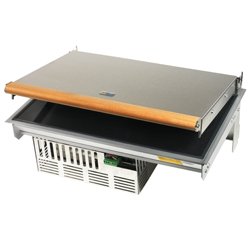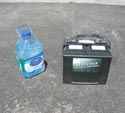Staying Warm or Keeping Cool

Heating and cooling systems add immensely to cruising comfort, whether you boat in cool shoulder seasons or contend with hot, muggy summers.
Most boaters learn quickly that extending their season is ideal – Canadian summers are so short, whether you’re on the west coast or the Great Lakes. In central areas, summer is short but it can be hot and humid, and winter is too cold for much cruising in all parts of Canada. Extending into spring and fall makes boating so much more enjoyable, to say nothing of helping justify the costs.
The addition of heating and cooling systems aboard is a sensible upgrade that can easily double the effective cruising season. September-October and April-May can bring great cruising weather, often with clear skies, but their lower temperatures mean some technology aboard is needed.
Marine Heat
Heating a boat is easier than cooling it thanks to the number of ways we can create heat. Burning a fuel is the easiest. But large boats with the luxury of onboard generators can always use electrical heat. This is often called direct element heat as the electricity is converted to heat directly through a high-resistance element and it is 100-percent efficient. This method works for domestic water as well as for space; it’s clean, efficient and easily controlled. But for those of us who prefer not to use generators constantly, electric heat is not feasible. We need a fuel.
Wallas of Finland has a range of attractive products that combine space and cooking heat thanks to their unique designs of combo heater and domestic stove units. These provide cooking through their stovetop cookers, but also provide space heat for any boat cabin. They burn diesel fuel taken from main tanks. Wallas has a number of products in their line that can be used for stovetop, oven and space heating needs, as well as dedicated forced-air space heaters that burn diesel or kerosene.
Combining a space heat function with domestic hot water is the aim of BC’s International Thermal Research, which markets products under the Hurricane brand. Their hydronic (water-based) system features a diesel-fired marine boiler that heats circulating water and provides hot domestic water for showers, sinks and laundry. With a simple heat-exchange radiator system, the Hurricane heaters also provide space heat. They burn diesel fuel taken directly from the main tanks and need only 12-volt DC to operate.
Other marine heaters from European manufacturers such as Espar and Webasto are also commonly used onboard. These are sophisticated heaters that take diesel fuel from the main tanks and burn it in a small furnace. Unlike the hydronic systems, these furnaces create hot air directly, but they can also be plumbed with a heat-exchange coil to provide domestic water heating or feed small radiators. With technology improvements, these products are now easy to use with a plain on-off switch or a simple thermostat, as easy to use as common home systems.
Manufacturers such as Dickinson offer lines of diesel-burning space heaters. These require a bit more operator involvement to light the fire and adjust the flame, but are able to produce large quantities of reliable heat. We had a Dickinson Arctic heater on our 48’ cruiser for many years and it kept the boat nicely warm in any wintertime temperature that BC offered. These heaters, too, burn diesel fuel plumbed directly from main tanks but they need to be vented properly. And they work much better if they have a dedicated air supply. Dickinson also has a propane-burning bulkhead heater line.
In all cases, onboard heating systems need to be vented properly and exhausted carefully. Temperatures can get very hot and can endanger the vessel if improperly installed. If your boat does not already have carbon monoxide detectors, they are always advisable anytime there is a direct flame in the heating system.
Marine Cooling
More complicated than heating, cooling a vessel usually calls for a system comprising a compressor and evaporator, circulating fans, pumps and a fair bit of plumbing and electronic controls. Onboard cooling uses the same basic technology as refrigeration. In domestic applications there are many such cooling units commonly called “air conditioning.” Onboard though, these domestic units are impractical so some manufacturers have developed marine variations that are available to operate using electrical current from a generator or from a battery bank through an inverter. However, their electrical current draw is significant, commonly upwards of eight to 10 amps.
These systems take advantage of the latent heat that is released and gathered during the evaporative and condensing cycle of a fluid. All refrigeration and air-conditioning systems use this basic technology. The transmitting fluid must be easily evaporated and condensed – for years the choice was Freon, but it is no longer used, as it is harmful to the ozone in our atmosphere. Now all cooling units use alternatives, the most common being a variant of “green gas” such as R417 (Isceon 59) or R410A and variants.
This cooling technology actually moves heat from one area to another, hence any cooling unit must exhaust hotter air to the outside, or it must have a cooling coil to dissipate the heat, like any household refrigerator. Any domestic or marine refrigeration unit has a simple cooling coil at the rear of the unit and discharges the waste heat into the room. That’s not an issue in a fridge, as it is cooling inside the unit that is needed.
However, cooling the air in a room or cabin creates a challenge. The waste heat cannot be discharged back into the room, as that would defeat its purpose. Instead, most AC units use the cooling effect of the surrounding water to take away the waste heat. That means another through-hull fitting is needed and plumbing to and from the unit must be installed. This adds to the complexity and costs of installation as well as operation.
One manufacturer sells a portable AC unit that is designed to sit on top of a hatch. It does not require a through-hull as it supplies cooling air downwards into the boat and discharges its waste heat upwards into the atmosphere. Another makes a pure evaporative cooler that blows air through an ice pack. Some 12-volt systems cool moderately by simply evaporating water. However, these systems are not serious AC units as their output is very modest.
Several other manufacturers sell proper marine AC units of varying sizes that need to be permanently installed with electrical and plumbing connections.
The ideal installation uses a system of interior ductwork to distribute the cooling air throughout the vessel. Interior fans can aid this process, as hot air can be stubborn. Owners have also found that a simple exhaust fan near the top of the interior space is the best way to aid cool air circulation. Interior fans that aid circulation help in cooling larger spaces. An added advantage to AC systems is that they dehumidify air as they cool, adding a comfort bonus to boaters in hot and humid summers.
Owners of boats without AC units have found that blowing cool air into a boat is nowhere as effective as exhausting unwanted hot air. Hot-air exhaust fans will remove unwanted heat and then cool air from outside will find its own way in. Several manufacturers offer exhaust fans that are solar-powered so need no electrical connection. Others supply fans that need only small amounts of 12-volt electricity.
Reverse-Cycle Options
AC engineers soon found that a cooling unit could work in reverse and also supply heat. Heat is a waste product in cooling applications but it is a desired product in heating applications. Such units are called heat pumps because that describes their basic operation – they actually pump heat from one side of the system to the other. But the technology is identical to cooling units – they simply operate in reverse.
In domestic and commercial applications this technology has been around for decades and it is reliable and cost-effective. It still requires electrical power, but typical systems can easily produce three times more heat through their heat pump than they would be able to create with a simple direct heating element of the same electrical draw.
In marine applications these units are most often called reverse-cycle heating and cooling units. In one mode of operation they produce space heat. In reverse mode they provide cooling. A number of models are available from manufacturers including Marvair, CruiseAir, Flagship and Climma, among others. A typical small unit needed to cool a 26 to 30’ boat will provide 7,000 to 10,000 BTU cooling in reverse cycle and a similar amount of heat. It uses four to eight amps of current while running, slightly more when the compressor starts its cycle. While the main compressor needs 120-volt AC power, some have auxiliary fans that use only 12-volt DC, saving power use. But this amount of electrical draw still requires a fair-sized battery bank or an onboard generator to provide the current.
The advantages of these systems are many. They run fairly quietly and in one unit they provide heat in the cooler shoulder seasons and cooling for those hot and muggy summer days. They are a bit more expensive than stand-alone cooling or heating units but they save one whole system. Typical prices range from $2,000 up depending on the cooling and heating capacity needed.
Whichever system best suits your specific climate and comfort needs, the addition of heating or cooling equipment to your boat will easily double your effective cruising season, to say nothing of making any boat trip more pleasant.
Heating and Cooling Suppliers
Climma www.veco-na.com
Cruiseair, Dometic www.dometic.com
Dickinson www.dickinsonmarine.com
Espar www.espar.com
Flagship www.flagshipmarine.com
Hurricane www.itrheat.com
Mermaid www.defender.com
Marvair www.marvairmarine.net
Webasto www.webasto.com
Wallas www.wallas.ca
By Robert Buller





























